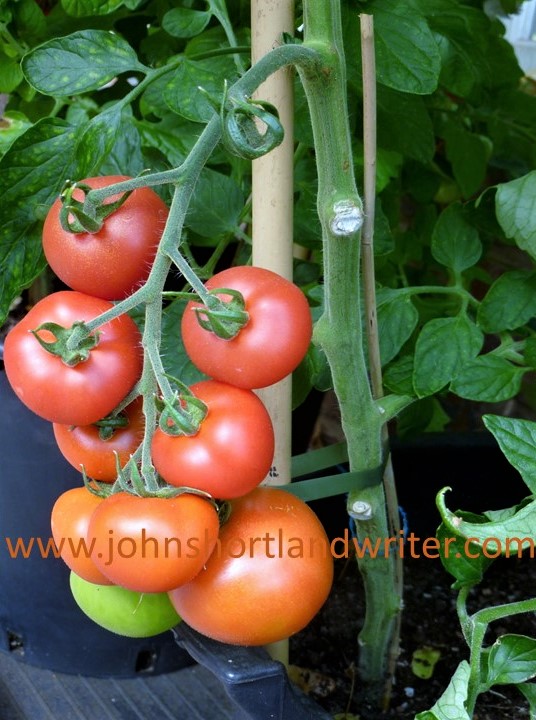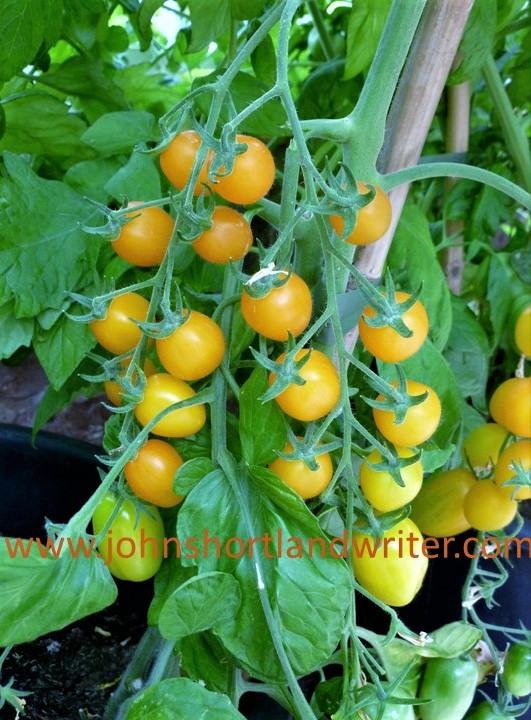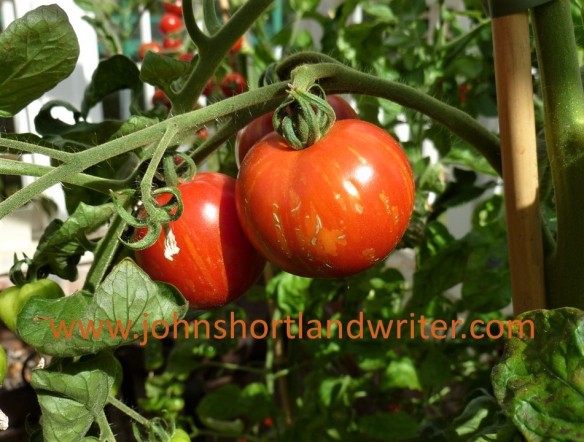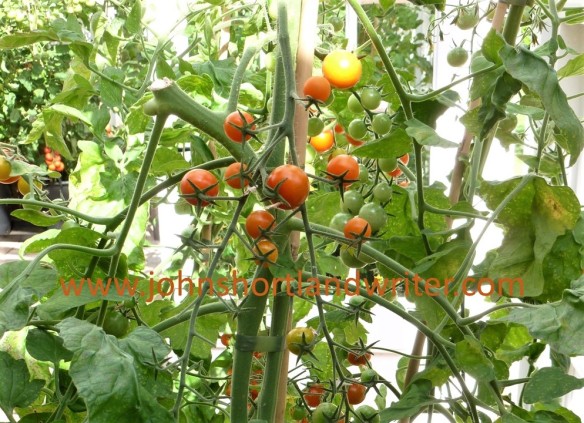It may seem odd writing about growing tomatoes at the time you should be harvesting them but it is often the case that when you see a plant growing somewhere that is the time you wish you knew how to grow them. As regular readers of my garden articles will know, although I love gardening I also like to achieve great results with the minimum of effort and tomatoes are not an exception! Effortless gardening doesn’t mean bad horticultural practice for you can hardly expect great results from shoddy workmanship wherever your interest lies. All the photographs below demonstrate that it is possible to have superb tomatoes without devoting every spare moment to growing them.

Perfect tomatoes can be grown quite easily using my method
As is often the case, I discovered this easy way to grow tomatoes out of necessity: a client wanted them but they only visited their country house irregularly and I could only devote one day a week to maintaining their grounds. That left about fifteen minutes a week for the tomatoes. This method, by the way, only works for plants grown in containers. Although they were grown in a greenhouse there is no reason why the same method could not be used for growing in pots outdoors although they are more at the mercy of the usually variable British summer weather (not variable this year, 2018!).

Tomato ‘Golden Sweet’
All garden plants, whether grown in containers or in the garden border require good growing conditions and this starts with getting the soil or potting compost right. Tomatoes are greedy feeders and books and articles always advise feeding the plants on a regular basis as soon as the first flowers show signs of turning into fruit. That is far too time consuming for my fifteen-minute rule! Instead, use a quality compost. I used Carr’s potting compost which is made from composted farmyard manure; although not the cheapest it is well worth paying the extra cost for the results that are obtained. There are, of course, other manufacturers that do something similar which, I daresay, will achieve similar results. To this compost I mix in several handfuls of horticultural grit and double the recommended amount of water-retaining granules – these swell upon contact with water, and release it gradually thereby reducing the necessity for regular watering.

Tomato ‘Cherrola’
Tomatoes are easy to grow from seed, sowing in gentle heat in February and there is a huge choice of variety. For ease and speed, I purchased young plants from a garden centre once I had no concern of late frosts killing them. The pots were filled to within a couple of inches of the brim with the compost mix which I had pre-moistened. As a guide, the compost should feel damp but you shouldn’t be able to squeeze water out of it. Plant three tomatoes in a 20/25 litre plant pot placing a sturdy cane by each plant. Stand the pot on a watering saucer or tray and water well. Gardening rules state that tomatoes don’t like standing in water but I found that by using the saucers I could leave them with a good supply to last them the week. By the time of my next visit, the compost and tray were dry but the plants unaffected by either the standing water or the drought.

‘Tigerella’, an heirloom variety of tomato with striped fruits
Tomatoes grow in two different ways depending upon the variety – bush or cordon. With bush tomatoes you just leave them to grow as they will; with cordons it is recommended that you remove side shoots and tie the plant upright onto the cane. Although the latter method sounds time consuming and fiddly it is a simple and quick task once it’s been mastered. The secret is to remove any shoots that grow out of the union of the leaf stalk with the main stem – if done early enough they snap off with the fingers. If you leave them they will need to be cut out with a knife or scissors. Although it is possible to leave them in situ I find that the plants become very congested and difficult to manage which, in the longer term, means they are more time consuming to deal with.

Tomato ‘Sungold’ – note how the plant has been ‘stopped’ when it had grown as tall as I wanted it to be.
And that’s it! Just tie the plants to the cane as they grow and give them a really thorough watering once a week from the top of the compost until the saucer begins to overflow. There’s no time-consuming feeding for the compost will provide all the necessary nutrients. And because the plants are growing strongly and healthily you are far less likely to be bothered by pests or diseases. All the tomatoes in the photographs received no chemicals or other additives; all we had to do was to eat them. If you’ve never tasted a home-grown tomato eaten the moment it is plucked from the vine then you’re in for a real treat!

A photograph from 1979! Tomato ‘Big Boy’, a beefsteak variety living up to it’s name!
